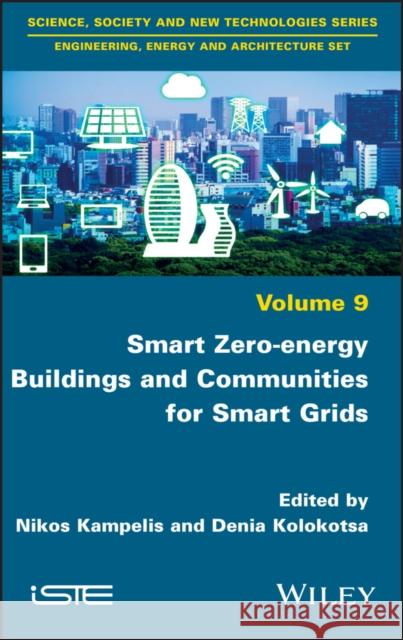Smart Zero-Energy Buildings and Communities for Smart Grids » książka



Smart Zero-Energy Buildings and Communities for Smart Grids
ISBN-13: 9781786306845 / Angielski / Twarda / 2022 / 320 str.
Smart Zero-Energy Buildings and Communities for Smart Grids
ISBN-13: 9781786306845 / Angielski / Twarda / 2022 / 320 str.
(netto: 671,82 VAT: 5%)
Najniższa cena z 30 dni: 701,06
ok. 30 dni roboczych
Dostawa w 2026 r.
Darmowa dostawa!
Preface xiNikos KAMPELISList of Acronyms xvNikos KAMPELISChapter 1 The Role of Smart Grids in the Building Sector 1Denia KOLOKOTSA1.1 Smart and zero-energy buildings 21.1.1 Smart metering 31.1.2 Demand response (DR) 41.1.3 Distributed systems 61.2 Smart and zero-energy communities 61.3 Conclusion and future prospects 10Chapter 2 Integrated Design (ID) Towards Smart Zero-energy Buildings and Smart Grids 13Theoni KARLESSI, Pietro MURATORE, Luca VENEZIA, Laura STANDARDI, Klemens LEUTGÖB and Anne Sigrid NORDBY2.1 Introduction 152.2 Methodology 162.3 Integrated design in smart and zero-energy buildings 172.4 ID process principles and guidelines 192.4.1 Benefits 222.4.2 Barriers 232.5 Scope of services 242.6 Remuneration models 262.7 Application of evaluation tools 282.8 Sustainability certification 292.9 Consultancy and quality assurance 302.10 Measurement of design quality criteria 312.11 Defining a client's objectives 332.11.1 Capital cost reduction 342.11.2 Delivery risk reduction 352.12 Defining the tenant's objectives 352.12.1 Operational cost reduction 362.12.2 Building unsuitability risk reduction 362.13 Best practice sites 372.13.1 Alexandros N Tombazis and Associates Architects S.A office building 372.13.2 APIVITA Commercial and Industrial S.A 422.13.3 Stavros Niarchos Foundation Cultural Center 462.13.4 Karelas Office Park 50Chapter 3 Data Analysis and Energy Modeling in Smart and Zero-energy Buildings and Communities 55Nikos KAMPELIS, Konstantinos GOBAKIS, Vagias VAGIAS, Denia KOLOKOTSA, Laura STANDARDI, Daniela ISIDORI, Cristina CRISTALLI, Fabio Maria MONTAGNINO, Filippo PAREDES, Pietro MURATORE, Luca VENEZIA, Marina Kyprianou DRACOU, Alaric MONTENON, Andri PYRGOU, Theoni KARLESSI and Mat SANTAMOURIS3.1 Energy signature for the NTL of Cyprus Institute 553.2 Athalassa Campus and the NTL building 573.2.1 Methodology 613.2.2 Description of the Novel Technology case study 633.2.3 Data exploration 683.2.4 Correlation matrix 713.2.5 Regression model 723.3 Linear Fresnel solar collector at the NTL building, Cyprus Institute 853.3.1 Development of the NTL model 903.3.2 Energy performance analysis in the NTL 923.3.3 Discussion 1003.4 Conclusion 101Chapter 4 On the Comparison of Occupancy in Relation to Energy Consumption and Indoor Environmental Quality: A Case Study 103Margarita Niki ASSIMAKOPOULOS, Nikolaos BARMPARESOS, Alexandros PANTAZARAS, Theoni KARLESSI and Siew Eang LEE4.1 Introduction 1034.2 Methodology 1044.3 Description of the case building 1054.4 Description of the experimental procedure 1054.5 Results 1064.5.1 Investigation of energy consumption and indoor air quality 1064.5.2 Days of special interest - high occupancy 1104.5.3 Days of special interest - increased energy consumption 1124.6 Discussion and concluding remarks 112Chapter 5 Indoor Environmental Quality and Energy Consumption Assessment and ANN Predictions for an Integrated Internet-based Energy Management System Towards a Zero-energy Building 115Denia KOLOKOTSA5.1 Introduction 1155.2 Description of the SDE buildings 1165.2.1 General information 1165.2.2 Monitoring activities for SDE 3 1185.3 The power loads and hourly energy consumption 1185.4 Indoor environmental quality 1185.4.1 Thermal comfort assessment - time series analysis 1275.4.2 Indoor air quality 1295.4.3 The indoor illuminance levels 1295.5 Cross correlation 1355.6 Prediction using artificial neural networks (ANN) 1365.6.1 Prediction of outdoor temperature 1375.6.2 Prediction of relative humidity 1385.6.3 Prediction of power loads 1395.7 Specifications for an integrated internet-based energy management system toward a zero-energy building 1415.7.1 The phases of the internet-based energy management system for SDE 1425.7.2 Integration of software and prediction algorithms 1495.8 Conclusion 149Chapter 6 Objective and Subjective Evaluation of Thermal Comfort in the Loccioni Leaf Lab, Italy 151Marina LASKARI, Francesco CARDUCCI, Daniela ISIDORI, Martina SENZACQUA, Laura STANDARDI and Cristina CRISTALLI6.1 Introduction 1516.2 Background information 1526.3 Methodology 1536.3.1 Subjective measurements 1546.3.2 Objective measurements 1546.3.3 Combined analysis of objective and subjective measurements 1556.3.4 User preferences and satisfaction with internal conditions 1576.4 Collection of building background data 1576.5 Collection of monitored data 1606.6 Right-Now questionnaire survey 1626.7 Results 1666.7.1 Analysis of MyLeaf measurements 1676.7.2 Analysis of Comfort Meter measurements 1736.7.3 Analysis of Right-Now survey responses 1766.7.4 Respondent characteristics and thermal comfort 1846.7.5 Combined analysis of objective and subjective measurements 1876.7.6 Correlation analysis for MyLeaf and Right-Now survey measurements 1906.7.7 Correlation analysis for objective and subjective measurements (Research for Innovation office space) 1916.7.8 Comparison between objective and subjective thermal sensation measurements 1956.7.9 Determination of acceptable and unacceptable conditions 1966.8 Conclusion 197Chapter 7 Smart Meters and User Engagement in the Leaf House 199Niki GAITANI7.1 Introduction 1997.2 Methodology 2007.3 Analysis of user engagement 2017.3.1 Development of the questionnaire 2017.3.2 Leaf House case study 2037.4 Results 2107.4.1 Demographics, socioeconomics 2107.4.2 Physiological, social and behavioral aspects 2127.4.3 Information level 2147.4.4 Health and comfort 2157.4.5 Living situation 2177.5 Conclusion 218Chapter 8 Integration of Energy Storage in Smart Communities and Smart Grids 221Denia KOLOKOTSA, Nikos KAMPELIS, Angeliki MAVRIGIANNAKI, Marco GENTILOZZI, Filippo PAREDES, Fabio Maria MONTAGNINO and Luca VENEZIA8.1 Energy storage systems in smart grids 2238.1.1 Electrical and electrochemical energy storage in smart grids 2238.1.2 Mechanical energy storage in smart grids 2288.1.3 Thermal energy storage in smart grids 2318.2 Energy storage and smart grids: case studies 2348.2.1 Case study 1: the Leaf Community smart grid energy storage system 2348.2.2 Case study 2: energy storage of CSP and integration with smart grids 2448.3 Conclusion and future prospects 261Conclusion and Recommendations 263Nikos KAMPELISReferences 267List of Authors 283Index 287
Nikos Kampelis is a researcher at the Energy Management in the Built Environment Research (EMBER) laboratory of the Technical University of Crete, Greece. His research focuses on the optimal integration of loads and renewable energy in smart buildings and smart grids.Denia Kolokotsa is Professor of Energy Resources Management and Dean of the School of Chemical and Environmental Engineering at the Technical University of Crete, Greece. She is the Editor-in-Chief of the Elsevier Solar Energy Advances Journal, and Subject Editor of the Nature Scientific Reports Journal. Her research interests include, among others, energy management for the built environment, energy efficiency and renewable energies, distributed energy management systems, building automation and design, development and energy management of microgrids and smart grids.
1997-2025 DolnySlask.com Agencja Internetowa
KrainaKsiazek.PL - Księgarnia Internetowa









